In my last post, I demonstrated, via too many charts, that the monster-creation math in the 5e Dungeon Master’s Guide doesn’t match the monsters in the Monster Manual. As an example: the average CR 1/4 monster has 13 hit points. The DMG suggests that they should have 43 hit points. Imagine your level-1 party mobbed by skeletons with 43 HP each instead of 13!
In my next post, I’ll be offering a chart to replace the one in the DMG, which lets you create monsters on the fly: monsters which are about as dangerous as you’d expect based on their Monster Manual cohort.
In between my last post and my next post, though, we need to do a little more analysis. Do legendary monsters skew the math? And has the math changed in recent D&D monster books, such as Mordenkainen’s Guide?
legendary monsters
Legendary monsters are the conceptual descendant of Fourth Edition’s “solo monster”: a single monster designed to challenge the whole party. If I remember right, solo monsters had 4x the hit points of a standard monster of their level. Are 5e’s legendary monsters’ HP similarly inflated?
There’s not much overlap, but it’s pretty clear that legendary and standard monster HP both fits on the same trend line.
I won’t show all the charts here, but I will tell you this: legendary monsters have basically the same armor class, hit points, attack bonuses, and save DCs as their non-legendary counterparts. The only chart that looks interesting, at first blush, is damage:
Legendary damage looks higher, right? But actually I think something else is going on. Dragons. They’re an outlier, with high stats in general: both high hit points and damage for their CR, plus a host of beneficial traits such as Legendary Resistance. Let’s break the legendary creature damage into dragons and non-dragons.
There are not a lot of non-draconic legendary monsters in the Monster Manual, but their damage totals (the green triangles) are on the same trend line as the standard monsters. The dragons form their own trend line, hovering threateningly over the other monsters.
So, in general, legendary monsters have the same stats as any standard monster. How is a legendary monster different?
Legendary monsters are more interestingly built. They have off-turn legendary actions. They may have lair actions. Some, but not all, have Legendary Resistance, so they can’t be shut down with one spell. But, apart from the dragons, they have the same hit points, damage per round, and other game statistics as any other monster of the same Challenge Rating.
Mordenkainen’s Guide
Our charts look plausible so far, but we’re hampered, especially at high level, by low sample size. Enter Mordenkainen’s Guide. Mordenkainen’s is notable because it’s chock full of high-level and legendary monsters: it contains as many CR 8+ monsters as the Monster Manual does, doubling my sample size for high-level monsters. (There are, of course, more monsters in Volo’s Guide and other sources, but I haven’t charted them yet.)
But are monsters in the Monster Manual and Mordenkainen’s comparable? Has monster design changed drastically in the four years since the Monster Manual was released?
First of all, how do Mordenkainen’s Guide hit points look compared to Monster Manual hit points?
Pretty much the same. In this graph, I’ve broken out the hit points of legendary and nonlegendary monsters from Mordenkainen’s so we can check our work from above: legendary monsters don’t have more hit points than other monsters. In fact, if anything, they have slightly fewer. Furthermore, the general hit point trend is the same for Monster Manual and Mordenkainen’s monsters.
I’ll skip over some other uninteresting charts: the long and short of it is, Mordenkainen’s Guide monsters have roughly same ACs, attack bonuses and save DCs as Monster Manual monsters of equal CR.
I do want to take a closer look at monster damage from Mordenkainen’s, however.
Here I’m graphing average Monster Manual damage/CR against Mordenkainen damage/CR. I’ve broken the Mordenkainen data into legendary and nonlegendary just to confirm that there is no significant difference between them. Mordenkainen damage is on par with Monster Manual damage. (Except for that spike at CR 18: that’s the sibriex, possibly the highest-damage-per-round monster in D&D except the tarrasque.)
Nevertheless, there is one statistical difference between the Monster Manual and Mordenkainen’s Guide damage that this chart doesn’t show.
The *standard deviation* – distance from the average – is much higher in Mordenkainen’s.
For the 75 CR 8+ monsters in MM, and the 75 CR 8+ monsters in Mordenkainen’s, the average standard deviation in the MM is 16, even including dragons, and in Mordenkainen’s it’s 21.
That means that high-level Mordenkainen’s Guide monster damage is 30% farther away from the norm compared to the Monster Manual. There is a little less predictability in how powerful a monster is given its CR. This may be a function of the increased complexity of the newer monsters. It may also be a sign that the game’s designers don’t care as much as they used to about adhering very closely to monster-creation guidelines. There’s more art and less math in Mordenkainen’s Guide.
Art is good. That said, there’s something to be said for consistency. Therefore, as a public service, here’s some monsters in Mordenkainen’s to watch out for if you want to avoid a TPK that surprises everyone, including the DM.
The Sibriex: this monster can drop 200 HP a round at CR 18, just about double what you’d expect from a CR 18 monster.
The Duergar Despot, CR 12: the despot fires the equivalent of two full-scale Lightning Bolts per turn. He can do 72 HP of damage to each PC he hits, which, in enclosed tunnels, may very well be all of them.
The Star Spawn Mangler, CR 5: on round 1 it can do 90 damage, all to the same enemy. A level 5 fighter may have 45 HP. DM and player alike may be surprised to see that front-line fighter not only dropped, but killed, during a surprise round, against an equal-CR opponent. Compare the Mangler’s damage to Geryon, the CR 22 legendary duke of Hell, who can do 77 damage on round 1. (Note: On round 2, the Mangler is useless. That’s how it’s balanced.)
Well, that ends my deep dive into… wait, you know what? let’s look at just one more delicious chart. Maybe two tops.
Challenge Rating and monster traits
One of my findings that surprised me the most from my examination of the Monster Manual was that a monster’s resistances and immunities don’t affect its hit points and damage. The DMG claims they affect hit points, and you can certainly find some MM monsters, like the wraith, who have lots of resistances and who have lower than average hit points. But those are balanced by other high-resistance high-hit point monsters.
Let’s look at the hit points of monsters with a lot of resistances and immunities in Mordenkainen’s.
There is no significant difference between the hit points of the general population and those monsters with 8 or more resistances and immunities!
There must be some traits that affect monster stats. Let’s look at regenerating monsters. We’d expect them to have lower hit points.
Finally, a correlation! Monsters with regeneration have lower max hit points than the general population – as we’d expect them to, since regeneration 10 over 3 turns should be worth 30 hit points.
Here are the monster traits which seem to have any noticeable correlation to stats:
Regeneration: Hit points lowered by 30 or more
Possession: Hit points halved
Damage transfer: With no degree of confidence because there are so few examples in either book, this may lower hit points or damage.
And that’s all I’ve found so far that makes any difference. The abilities to stun, charm, paralyze, or petrify don’t seem to make a difference to HP or damage, nor does magic resistance, legendary resistance, superior invisibility, or any of the other traits listed in the DMG – at least not enough to move the needle. That will all be useful information when we get to designing monsters.
I hope you enjoyed my descent into statistical madness! I want to point out here what I hope is obvious: I think 5e is great and I’m not looking to ruin anyone’s fun by examining its math. I just like figuring out how good things work, and, if possible, making them better.
In a few days I’ll deliver that much-promised build-a-monster-on-the-fly chart.
(Edit: In fact, next I talk about Jeremy Crawford on monster design)

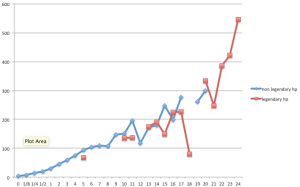


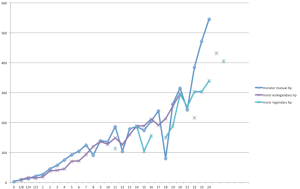
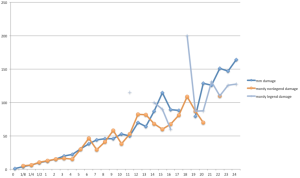
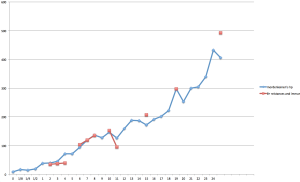
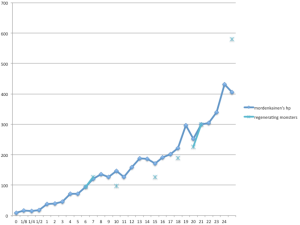







Yes, it was very interesting to me. I mostly reskin existing monsters, but now your writing encourages me to build something more original.
I am commenting this before reading the rest of the article, since I noticed some sensationalism in your firts paragraph. I’ll do some math regarding your first paragraph, in which you say skeletons are not following DMG design rules.
Defensive CR: Hit points 13 (1/8); AC 13 (1/8). Average 1/8
Offensive CR: Damage per Round 5 (1/4), Attack bonus +4 (3). Average 1, (1/4 scaled up 2 degrees, due to attack bonus being 4 degrees higher)
Average CR: Offensive CR 1 and Defensive CR 1/8. The average would fall right in the middle of 1/4 and 1/2, since the book states to round down. Final 1/4.
So, I don’t see where the DMG doesn’t match the MM.
Alan, I know it’s been many months but I’d like to reply that your calculation is wrong… Not mathematically, it’s just that you didn’t pay attention to the guidelines the DMG gives for finding the partial CRs.
Your Defensive CR ended up correct, but the Offensive CR is way off. First, you have to find the damage per round the monster deals, which in the case of a skeleton is 5, and then see which CR that is equivalent to (1/4). Then, you check the corresponding attack bonus, which in the case of a CR 1/4 creature is +3. If the attack bonus is different, you have to adjust the Offensive CR to the next for each 2 points it is higher or lower.
So, for a skeleton, the +4 attack bonus is not enough to bump it from Offensive CR 1/4 to 1/2. In the end, the average of it’s CRs is between 1/8 Defensive and 1/4 Offensive, giving it a final CR of 1/8, rounding down. So in the end the skeleton is still weaker than it’s “supposed” to be according to the DMG.